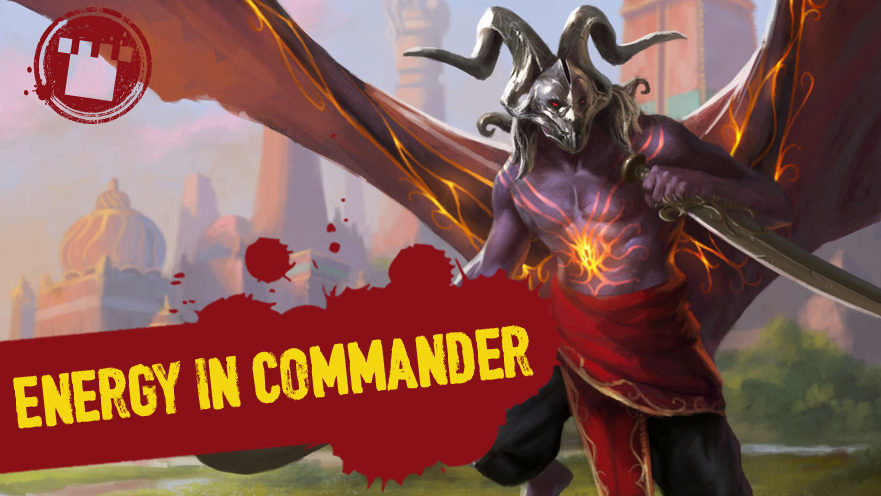Every so often, I like to take the “best” deck in Standard and see how it’d fare in Commander, and building an Energy Commander deck was an opportunity I couldn’t pass up. The Energy archetype had been on my radar for a while, but hadn’t heard of or seen any lists that were successful. With the most popular deck in Standard getting nerfed a few weeks ago, and the impending rotation of Kaladesh later this year, I figured now was a really good time to give Energy a rogue refining, and a glorious send-off.
WHY ENERGY?
Typically, this is where I talk about the Commander(s), which I will, but this idea began in reverse, so… Bottoms up!
Energy is a resource that creates all sorts of atypical interactions in Magic, and that’s especially true in Commander. Despite the novelty that comes with each new set, Commander has always been a format that gravitates towards the sort of “evergreen” fundamentals of Magic, and definitely not this offbeat, Kaladesh-specific resource.
While the most obvious question we could ask is, “Is there a Commander deck here?” the question I set out to answer was, “What does Energy do that will contribute to a winning strategy?” It’s easy to see Energy as more of a Rube Goldberg machine than an effective resource, and so I set out with the intention of doing just that.
But first, I needed a Commander. Or maybe two.

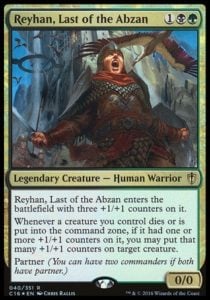
With the Standard Energy deck in mind, I had my heart set on building a four-color deck – the classic combination of Temur-plus-Black – but wasn’t digging my options. One of the reasons the Energy deck had been so successful in Standard is that the sum of the parts is greater than the whole. No matter what combinations I came up with, I couldn’t see a strong non-white color pair emerging.
Before I succumbed to the loving arms of Atraxa, I decided to widen my Commander options by narrowing my color options, and I found success. I wanted to incorporate Kaladesh’s modules and puzzleknots into the deck and realized that Silas Renn seemed like just the Commander to keep such a deck on track. Plus, with Reyhan, Last of the Abzan as his Partner, we could best utilize Skyship Plunderer and Standard’s sneakiest snek, Winding Constrictor.
THE PLAN
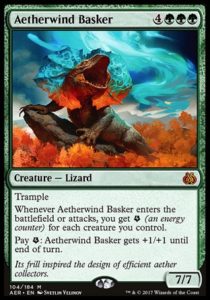
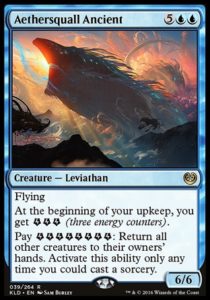
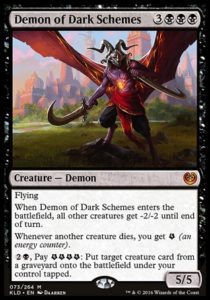
So what does our Energy do? The easy answer is a lot. It’s currency we can exchange for any number of things. It fixes our mana, draws us some cards, and powers up our creatures. But what’s important is Energy’s core competency: through precision and careful use, we can build and stockpile this resource to create some powerful, resilient end-game threats.
Our strategy is linear, but simple. We want to build our Energy stores and card advantage until we can either assemble a strong engine, or power out one of our big threats: Aetherwind Basker, Aethersquall Ancient, and the Demon of Dark Schemes.
THE DECK
View this deck on TappedOut.
Buy this deck from Card Kingdom.
This deck is a ton of fun, and it’s all made possible by the flexible Plinko Machine provided by Energy that gets us from A to B in a handful of value-driven ways.
Let’s start with the mana base, which can be slow at times, but provides powerful color support. Vivid and Temple lands provide our Ravnica bounce lands with useful resets, while our Pain lands were left in for Gonti’s Machinations, a late cut that I’m considering bringing back in the future.
Generally, our Signets, Myriad Landscape, and Servant of the Conduit can prevent us from falling behind while also helping to offset the hefty triple-green or triple-black mana costs for Aetherwind Basker or Demon of Dark Schemes.
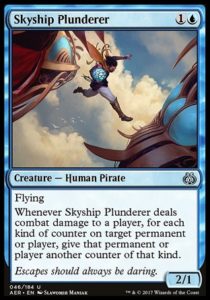


Moving into the mid-game, we should be beginning to generate Energy and other tangible value. Skyship Plunderer, Thrummingbird, and Winding Constrictor combine with most of our Energy makers to help grow our resources, while +1/+1 counter-based cards like Reyhan, Fabrication Module, and Hadana’s Climb work in tandem to make our Proliferate triggers more impactful.
To ensure consistency, we have a modest set of tutors, plus a strong Uncage the Menagerie package. At converted mana costs two and three, Uncage can grab a combination of Proliferate creatures, Energy makers, Den Protector + Eternal Witness, or Fierce Empath, which can go get us one of our game-enders.
While our deck isn’t prepared to do any serious disruption, there is plenty of room to set up recurring engines that will be tough to beat. Oversold Cemetery, Phyrexian Reclamation, and a flipped Journey to Eternity provide a great Reanimation plan, while Eternal Witness and Den Protector can do a handy impression of the old Crush of Tentacles deck from a season ago, the bonus being that we also get to bounce our own Energy makers, too.
RESULTS
The results have been very surprising. Politically, it’s difficult to know whether or not having a lot of Energy is good, let alone what number is dangerous, since other players aren’t sure how to value Energy as a resource. Often, the perception is based on immediate value, i.e., what we can do based on what is immediately on the battlefield. This plays to our advantage – not only are we likely able to get back whatever our opponents want to disrupt, but we are also able to alter our plans based on what they think could be the most problematic. With Proliferated Planeswalkers and flipped legendary enchantments, our Energy threats may not even be their biggest problem!
What I love most about this deck is that you are often directly rewarded for the effort needed to pilot it. It’s tricky, intricate, and smooth, despite all the things we thought we knew about Energy. I’m very much looking forward to continuing to test and tune this list!
Header design: Justin Treadway
Header image: “Demon of Dark Schemes” by Daarken

For most of his Magic-playing life, Aaron has been playing and writing about Commander. One of the few mono-colored players in a gold-bordered world, Aaron enjoys the challenges of creating meaningful, memorable games, as well as the excitement that comes with engaging underrated cards as he explores the format’s uncharted territory. A disciplined deckbuilder with over 200 lists to his name, Aaron has spent the past several years creating content about his favorite format.

